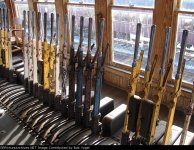Steve77
Elite Member
I have an old railroad track running the depth of my property. The tracks are long gone but the mound that the tracks were on is clearly visible and runs right through my house!
I hunted along the RR bed and was finding odds and ends and some large iron stuff. I was digging every solid tone above FOIL on my silver Umax like I usually do.
I found 2 cogs that were each semicircular. I looked at them to see if they had been broken in halves from the same piece but they are clearly not broken and were made this shape originally. any ID help on these is welcome. the picture with both half gears shows one face up and the other face down. they are about 2 1/2 inches thick overall
I had found another half gear like these about 3/4 of a mile east of here along the railroad bed last year, but if I remember correctly it was a bit smaller.

I hunted along the RR bed and was finding odds and ends and some large iron stuff. I was digging every solid tone above FOIL on my silver Umax like I usually do.
I found 2 cogs that were each semicircular. I looked at them to see if they had been broken in halves from the same piece but they are clearly not broken and were made this shape originally. any ID help on these is welcome. the picture with both half gears shows one face up and the other face down. they are about 2 1/2 inches thick overall
I had found another half gear like these about 3/4 of a mile east of here along the railroad bed last year, but if I remember correctly it was a bit smaller.



 Well, I'd guess that your half-gears were stationary, bolted to something and engaged with something *else* that had a back and forth range of motion. OR due to the length of the "teeth" (or convesely the depth of the grooves), it was designed to maintain the back and forth motion preventing the moving part from disengaging while in motion. A safety of sorts. So an assembly closer to the steam piston part of the loco, than the flywheel rod.
Well, I'd guess that your half-gears were stationary, bolted to something and engaged with something *else* that had a back and forth range of motion. OR due to the length of the "teeth" (or convesely the depth of the grooves), it was designed to maintain the back and forth motion preventing the moving part from disengaging while in motion. A safety of sorts. So an assembly closer to the steam piston part of the loco, than the flywheel rod.

